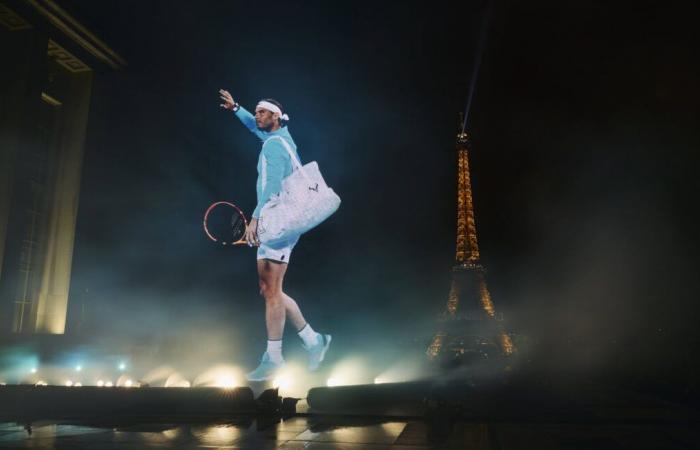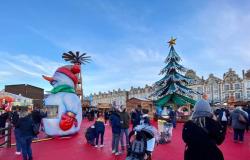
Nadal and tennis are definitely history after Spain's defeat on Tuesday in the Davis Cup quarter-finals. On this occasion, “20 Minutes” is publishing a series of articles on the tennis legend with 22 Grand Slam titles. Today, a look back at his link with France, forged over his 14 victories at Roland-Garros.
Between Rafael Nadal and France, it is the story of an obvious fact as much as an anomaly. Let us all be aware of the aberration: we are talking about a Spanish player, already, which in the field of sport is normally enough to classify you in the category of enemies of the nation without even trying to understand , who spent his time tormenting any Frenchman who came in front of him and who built himself a villa at Porte d'Auteuil without asking anyone's permission. But Nadal, of course, is the one who will have in fine sublimated the Parisian clay court, making it the scene of one of the greatest exploits in the history of sport, year after year, until being welcomed there with the deference due to it.
The cyborg become human
The story of the link woven between the Majorcan and the French capital is not that of immediate love at first sight, of a people who fall under the spell of a graceful player with a refined style. This one was reserved for someone else, Roger Federer not to name him, and this is where a sort of incomprehension arose following his first title at Roland-Garros, in 2005. “Spain was already coming out of domination at the end of the 90s, and to see another Spaniard winning while being so superior surely upset the public a little,” the former finalist told us (1998 and 2001) Alex Corretja in May, during the last Porte d'Auteuil edition. Especially when the impudent young man, with his tank top revealing a mutant's left arm, threatens to prevent the coronation of the Swiss darling forever.
The first turning point in this long-term story dates from 2009, when Nadal, with weak knees, fell without warning in the round of 16 against the surprising Robin Soderling. After three defeats in a row in the final, including a real humiliation the previous year (6-1, 6-3, 6-0 in 1h48 of play, the Swiss' heaviest defeat in a Grand Slam), Federer took the opportunity to conquer the the only Major who still refused him. A sort of relief for everyone, as if now that His Majesty had won one, we would really be able to take stock of the monumental work that the Spaniard was building in our garden.
But we had to wait a little longer, all the same. “The French don't like athletes who win all the time. After seven, eight, nine Roland-Garros, they were a little fed up with Nadal, observes Laurent Luyat, who will not have missed anything of the Spaniard's reign from the terrace of France Télévisions. And then there was a change in people's minds, after the Australian Open where he came back and lost in the final to Federer [en 2017]. I really noticed that. »
That season marked the great return of the man with the devastating forehand lasso, after two seasons in which he suffered a string of injuries. The first cracks in the armor, which will call for others, and which undermine the cyborg image that he had built in spite of himself. Paradoxically, they will help to bring him closer to the French public. “People saw that he was not only a physical monster, but someone with an exceptional mentality, a fighter who overcame all difficulties,” continues Laurent Luyat. From that moment on, the general public began to love him enormously. »
The series of four victories in a row which then begins resembles a golden period, where a strong and lasting bond is built between a player (more or less) at the top of his form and a public which better appreciates the chance to see write history before his eyes. “The trend has completely reversed, and it’s also thanks to him,” believes the France TV presenter. He showed other things of his personality, of his talent. »
The echoes that came from members of the organization about his kindness, his humility, his simplicity, found resonance outside. “He evolved, opened up about his personal journey, his difficulties, and little by little developed another facet which made him even more endearing, what he really is off the court,” confirms Pierre Rabadan .
“In a word, he’s a good guy”
Advisor to Anne Hidalgo from 2015 then appointed deputy mayor of Paris in charge of sports in 2020, the former rugby player had the opportunity to meet Rafael Nadal on numerous occasions, Porte d'Auteuil or during receptions at City Hall after his victories. “In a word, he’s a good guy,” he reports. He takes care of people, he is open. He is ultimately someone who is abnormal because of the champion that he is but completely normal in his human relationships. That's what I find most appreciable about him. »
Laurent Luyat has anecdotes galore on this subject. He remembers, for example, a post-final interview where, despite cramps, Nadal walked around the board to greet all the technicians. Or that time when, away from the cameras, he gave all his equipment to young people with disabilities who came to see him. “That’s it, that’s Nadal,” explains the journalist. A sensitive, very human being. I admit to having a strong attachment, and I am not the only one. Everyone who comes into contact with him says it, and the public felt it too at some point. »
The apotheosis of the Olympic opening ceremony
“I am amazed by the popularity he now has with the French,” adds Guillaume Lagnel, author of the book “Nadal, the ultimate warrior”, published in 2022. On his last match at Roland, you have the impression that it is a living god who enters an arena. Paris has a very special place for him, there is an unwavering link between the two. » An attachment which certainly crossed the ultimate threshold, on July 26, during the opening ceremony of the Olympic Games.
“The mayor [Anne Hidalgo] strongly insisted on the Organizing Committee for it to be part of it, for the symbol it represents, its history with Paris which goes beyond the simple relationship between a city and an athlete who distinguished himself there , says Pierre Rabadan. Afterwards, at what moment he intervened, we didn't know, because it was also good to keep the surprise. » And what a surprise!
On the wet stage of the Trocadéro, the Spaniard received the Flame from the hands of our divinity, Zinédine Zidane – who had presented him with his very first Trophy at Roland –, before joining the legends Carl Lewis, Serena Williams and Nadia Comaneci on the Seine. One of the strongest sequences of this evening, about which the Majorcan did not have words strong enough in private to express his emotion and gratitude. “The place that was given to him is the one he deserves,” appreciates Rabadan.
OUR FILE ON RAFA
Now that everything is over, that we are sure that Rafa will not return as a player, it is time to think about the tribute that will be organized in his honor next spring, in Paris. Everyone hopes that the Federation will rise to the moment. Given the message left for him by tournament director Amélie Mauresmo on Wednesday, it should be worth the trip. “It’s going to be very funny,” Lolo Luyat is already planning, who cannot guarantee that he won’t shed a little tear.





